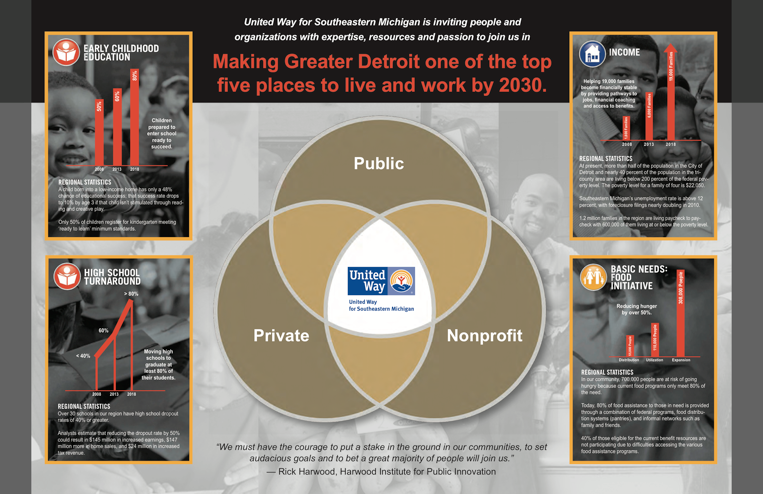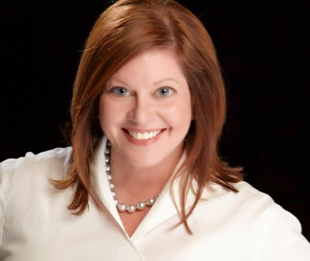CDE project 6. Section 5.4: an emotional major donor
In the latest addition to CDE project 6, the use and misuse of emotion, fundraising great Tammy Zonker shares the story of how United Way for Southeastern Michigan (UWSEM) persuaded a major corporate donor to partner with them in making a difference for the people of Detroit.
- Written by
- Tammy Zonker
- Added
- July 10, 2018
The use and misuse of emotion. Section 5: the inspiration business.
5.4b
An emotional major donor
The moving story of a really big transformational gift. by Tammy Zonker
It was the Great American Recession and Detroit’s unemployment hovered at thirty per cent. Two of the ‘Big Three’ automakers were in bankruptcy. Detroit’s population had plummeted since 2008 from nearly three million to about a million. Good, hardworking Detroiters walking away from their mortgages in search of means to take care of their families.
Meet one courageous leader and board at the United Way for Southeastern Michigan (UWSEM). Then President and CEO Michael Brennan and the UWSEM board of directors declared a Jim Collins-worthy (Good to Great) Big Hairy Audacious Goal (BHAG): make Greater Detroit a top five city to work and live by 2030.
UWSEM had identified four strategic initiatives to drive success:
- Increase high school graduation rates from <50 per cent to 80 per cent or greater by 2018.
- Increase kindergarten readiness from <50 per cent to 80 per cent or greater by 2018.
- Triple access to food to address hunger issues in the region.
- Increase the net worth of 16,000 residents through financial education and job skills building.
Meet Mark Reuss, President of General Motors North American Operations. Though a long-time General Motors (GM) employee, Mark was new to the role of president - and what a job he signed-up for! A Fortune 10 company in bankruptcy, thousands of GM employees laid-off, consumer affinity at an all-time low, late night talk show hosts quipping jokes about ‘Government Motors’.

Late summer, it was time to gear-up for UWSEM’s annual workplace giving campaign. Our traditional campaign launch included a ‘CEO Visit’ to secure endorsement at the top of each corporate partner. Volunteer campaign chair Jeff Bergeron secured the meeting with Mark.
(Jeff attended every meeting to follow as well – fundraising staff simply cannot maximise major gift success without remarkable volunteer leadership!)
We were ushered into Mark’s private conference room, warm but brief introductions were made between Michael, Jeff, Mark and myself as senior director of corporate relations. In short order Mark said,
‘We appreciate the work that you do, but obviously we’re in bankruptcy so we won’t be making a corporate gift. We’ve had to lay-off a lot of employees, but we’ll do our best to run an employee giving campaign’.

We thanked him for GM’s long-time and extraordinary support but explained that we weren’t there to talk about money, we were there to talk about our work. At which point we handed him our BHAG placemat and declared,
‘We have an audacious goal of making Greater Detroit a top five city to live and work by 2030’.

We described our strategies to get there and extended an invitation.
‘You are leading GM through a transformational journey to get back on its feet. We need your thinking on our transformational work too’.
The one ‘ask’ at that meeting was not for money. We asked him to tour our office. Within a few weeks, Mark’s tour date arrived. We wanted to create an organic experience that would allow him to truly feel the impact of our work. Of course behind the scenes this tour was orchestrated like a space shuttle launch!
The first tour stop was our 211 call centre, where we received more than 400,000 calls for basic needs assistance annually. He signed a confidentiality agreement, strapped on a headset and sat side-by-side with a care manager, listening to incoming calls.
It was telling to watch Mark’s normally warm expression change to concern and empathy as one caller shared that he’s a retiree on a small fixed income. For the past three months he’s had to choose between his prescription medication and paying his rent. That day he came home to find an eviction notice on the door and all of his possessions including medication locked inside.
The tour culminated in our ‘War Room’ where each strategic initiative was displayed along with a progress status. We talked through where we were having success and where we were stopped or stalled. The more transparent and vulnerable we became, the more Mark shared. ‘We’ve lost our soul at GM. We’ve forgotten who we are,’ he said. He vowed this once great company would be great again and would repay its debt both financially and emotionally to Detroit and our country.
Michael Tenbusch, United Way’s vice president of educational preparedness talked about five high school turnaround pilots previously reporting graduation rates of <40 per cent, that had increased to 70 per cent or greater in three years. We declared that this wasn’t enough to stop the hemorrhaging of high school dropouts. We must get to the root cause of the problem through early childhood education. We must ensure children and families are stabilised through financial education and access to nutritious food to support their growth and development. After all, if you can’t keep the lights on at home, or feed your family – they aren’t positioned to learn in school.
The one ‘ask’ coming out of that meeting was not for money. We asked him to tour Cody High School where transformation was clawing its way to the surface thanks to United Way’s turnaround partnership with Detroit Public Schools. To which he replied,
‘I’ll take your high school tour. But at the end of the tour, I’d like to see a proposal for what it would take to turn around five more schools’.

By mid-September 2010 Mark arrived at Cody High School. As background, Cody High School was built in Detroit’s west side in the 1950’s. Now this struggling community is home to urban blight and gang violence. In June of 2009, a gang-related mass shooting occurred at a bus stop near Cody, leading to seven injuries. As of 2012 Chastity Pratt of the Detroit Free Press wrote about ‘gang fights that made the (Cody) campus a tinder box’.
Mark entered Cody through the same metal detectors as students. We observed classrooms in session, walked the halls now adorned with positive affirmations amidst the security checkpoints. The tour ended in a non-descript conference room. There, four principals told the story of new Cody. They told their personal stories of being raised in the inner-city with the odds stacked against them and how education was their saving grace. Working with Cody students facing the same or worse plight compels them to work 14+ hour days, give students their personal cell phone numbers and encourage them to reach out day or night.
Three Cody sophomores joined us and each told their own story. One of these stories was told by a student named Destinee. A year prior she didn’t want to attend Cody as an incoming freshman. She had friends who were injured in a gang-related shooting at a bus stop near Cody the prior spring. But she enrolled anyway, because she lived in the neighborhood with her mother.
Destinee explained that shortly into the school year,
‘My mom and I couldn’t get along, and she put me out. I tried living with my dad, but that didn’t work. So now I live with my aunt in another school district. I take three buses to get to Cody every morning’.
Mark asked her why she didn’t just go to the school in her aunt’s neighborhood, to which she replied,
‘Because here they know my name. If I don’t show up to school, they’re blowing up my phone asking ‘where are you?’.
And when upper classman approach Destinee pressuring her into dangerous activities, she says
‘My principal Mr. Matthews got my back. He’s my big dog!’
Cody High School - it’s principals, teachers and the United Way turnaround team have become the family that Destinee and hundreds of other vulnerable Detroit youth can count on to protect and guide them as they become who they were born to be. As Destinee and the other students and principals left the room, there wasn’t a dry eye among us.

All agreed, how can you meet these kids, hear their stories and do nothing?
I then had the great privilege of walking Mark through the proposal to turn around five more Detroit public schools, develop five new early childhood learning communities and engage GM employee volunteers in our community through the GM and United Way partnership. When I finished reviewing the detailed budget, our CEO Michael Brennan said,
‘Mark, we’re asking General Motors to make an investment of $27.1M in our work.’
And then there was a seeming eternity of silence as Mark considered the request. Mark looked up from the proposal and said,
‘Let’s do this. I have no idea how we’re going to do this, but let’s do it!
Fast forward to the happy ending, November 17th 2010, GM exited bankruptcy and launched its IPO on the New York Stock Exchange. December 10th 2010, Mark Reuss and Destinee held a press conference at Cody High School and announced that the General Motors Foundation would make a $27.1 million investment in United Way for Southeastern Michigan’s Educational Preparedness Initiative.
The first-hand donor experience of seeing and feeling the need, meeting the potential beneficiaries of philanthropic support (respectfully, in an empowering manner) was at the heart of this donor experience resulting in the transformational gift of a lifetime for this fundraiser.
Tammy Zonker

440 Burroughs Street, Suite 639 Detroit, MI USA 48202
Mobile: +1.260.438.9325
Email: tammy@tammyzonker.com
Prepared for CDE PROJECT 6 – the use and misuse of EMOTION

Tammy Zonker is an envelope-pushing fundraiser, an inspiring international speaker and a powerful trainer in the discipline of transformational fundraising. In the past decade she has trained and led teams to raise more than $400M including the single gift of $27.1M described above. She moved to Detroit in 2008 motivated to fundraise in the most challenging economy in the U.S. and has turned those experiences into strategies and tools for creating transformational fundraising results in any economy.
















